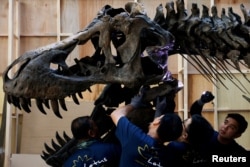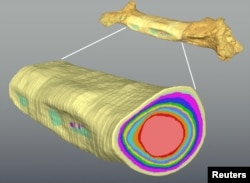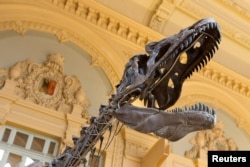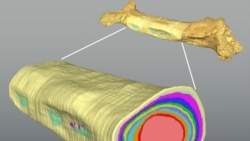A new study has found that a dinosaur’s size was not necessarily linked to how quickly it grew.
The research results come from studying a group of dinosaurs called theropods. Some theropods, like the meat-eating Tyrannosaurus rex, could grow to about the size of a bus. Others were much smaller, including some that grew to about the size of a cat.
Scientists have long believed that theropods generally followed a set pattern for growth. It was thought that dinosaurs that grew the fastest also got bigger than other theropods. And the ones that grew slower were believed to grow up to be smaller.
But the new study – which recently appeared in the publication Science – raises questions about that theory.
The researchers examined rings called “cortical growth marks” in different theropod species. The marks appeared inside the dinosaurs’ bones each year. They are similar to rings inside a tree that can be counted to tell how old the tree is. Widely spaced rings suggest a faster growth rate, while closely spaced rings suggest slower growth.
The scientists found no common pattern linked to body size. Some huge theropods grew quickly and stopped growing, while some grew slower over a longer period of time to reach the same size. Some small theropods grew quickly and others grew slowly.
Mike D'Emic is a professor of biology at Adelphi University in New York City. He was the lead writer of the study. D'Emic told Reuters news agency the latest research “overturns” past thinking about the growth of theropods.
He added that the study suggests other groups should also be studied to see if the research results hold up with other animals.
"It's equally likely that an animal evolved larger body size by growing at the same rate for longer, rather than just growing faster,” D'Emic said. “It is surprising and important to know that animals are just as likely to evolve to gigantic sizes at slow rates.”
The study found that Tyrannosaurus rex – which could grow to 12 meters long – was an example of a big and fast-growing theropod. Acrocanthosaurus – which is a bit smaller than T. rex – was an example of a big but slow-growing theropod.
The researchers said the 2-meter-long Coelophysis was a fast-growing, smaller theropod. Xixianykus, one of the tiniest dinosaurs at 50 centimeters long, was a small and slow-growing theropod.
The study found that Spinosaurus – a 15-meter theropod that spent time on land and in the water – grew much more slowly than Tyrannosaurus. And it found that Mapusaurus, which reached about 11.5 meters, grew even faster than Tyrannosaurus.
Patrick O'Connor is an evolutionary biologist and was a co-writer of the study. He told Reuters that the study should open the door to new research about how growth rates are connected to the size of many different animal groups.
I’m Bryan Lynn.
Reuters and Ohio University reported on this story. Bryan Lynn adapted the reports for VOA Learning English.
__________________________________________________________________
Words in This Story
pattern – n. a regular and repeated way in which something happens
species – n. a group of animals or plants that are similar and can produce young animals or plants
evolve – v. to develop or make something develop over time
gigantic – adj. very large
tiny – adj. very small
evolution – n. the way in which living things gradually change and develop over millions of years
____________________________________________________________________
What do you think of this story? We want to hear from you. We have a new comment system. Here is how it works:
- Write your comment in the box.
- Under the box, you can see four images for social media accounts. They are for Disqus, Facebook, Twitter and Google.
- Click on one image and a box appears. Enter the login for your social media account. Or you may create one on the Disqus system. It is the blue circle with “D” on it. It is free.
Each time you return to comment on the Learning English site, you can use your account and see your comments and replies to them. Our comment policy is here.














Forum